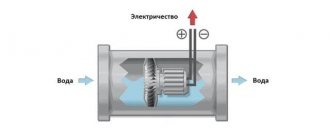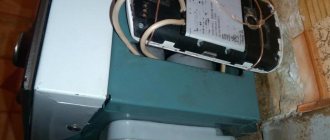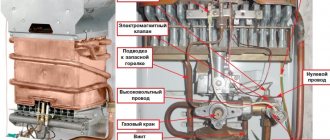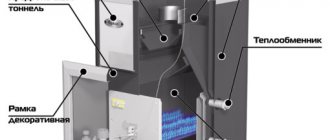Replacing the battery in the Neva gas water heater
Essentially, the replacement principle is the same in all such devices. The method described below can also be applied to speakers from another company, for example, Ariston.
You do not need to open the device case. Just look for the plastic case on the lower right side. This is where the batteries are located. To access them, simply turn the flag or press the latch and pull the cover down. Next, take out the energy sources and use them to purchase new ones in the store. Typically, the Neva gas water heater uses R20 batteries. In appearance they resemble round barrels. There can be from 1 to 2 pieces.
We install new ones, close the lid and check the device for functionality! It should work! If this does not happen, then the reason why the device does not start is completely different. There might be something wrong with the membrane.
In some speakers things may be a little different. Although in general terms the replacement scheme is similar. We look again at the lower right corner. There is a flag that secures the lid. To replace, rotate the flag along the long line and click on the central part of the box. After this, a special case will come out, on which it will be briefly written how to insert the batteries according to the polarity. After installing the new batteries, place the container back and pull it until it clicks.
How to replace the battery
In a geyser, the source of electricity is located in a special compartment located in an easily accessible place. Taking into account the design and functional features of the water heater, this is its lower part.
To gain access to the batteries, you must remove the cover, which is held in place by a latch.
The compartment contains 2 batteries held in place by latches. Having remembered the polarity of each, we press on the latch, and the battery slides out under its own weight.
The other power source is removed in the same way. New ones are inserted and fixed, observing polarity. The lid closes. The gas water heater is ready for use.
In some models, a successful replacement is completed with a light or sound signal.
The speaker housing or opening cover may indicate the correct polarity of the connection. Insert new elements in the same way as the previous ones were placed
Replacing the battery in the Neva gas water heater
Essentially, the replacement principle is the same in all such devices. The method described below can also be applied to speakers from another company, for example, Ariston.
You do not need to open the device case. Just look for the plastic case on the lower right side. This is where the batteries are located. To access them, simply turn the flag or press the latch and pull the cover down. Next, take out the energy sources and use them to purchase new ones in the store. Typically, the Neva gas water heater uses R20 batteries. In appearance they resemble round barrels. There can be from 1 to 2 pieces.
We install new ones, close the lid and check the device for functionality! It should work! If this does not happen, then the reason why the device does not start is completely different. There might be something wrong with the membrane.
In some speakers things may be a little different. Although in general terms the replacement scheme is similar. We look again at the lower right corner. There is a flag that secures the lid. To replace, rotate the flag along the long line and click on the central part of the box. After this, a special case will come out, on which it will be briefly written how to insert the batteries according to the polarity. After installing the new batteries, place the container back and pull it until it clicks.
Video on replacing batteries in a Neva gas water heater
We replace the battery in the gas water heater with a power supply!
The geyser is the “heart” of the water heating system of a private house or apartment. Maintaining this type of equipment requires certain knowledge and skills, right? You don’t know what batteries are needed for a gas water heater and how to replace them correctly?
We will help you sort out these issues - in the article we will look at the types of batteries used for the speaker and detailed instructions for replacement. We will also look at the reasons why they become unusable and how to choose new ones correctly. The publication is equipped with visual photos and videos, which will help solve a number of operational problems associated with the use, selection and replacement of power supplies.
Features of batteries for the speaker and nuances of choice
Modern speaker models rely on electricity to operate. The power supply, thanks to the spark produced, ignites the flame necessary to heat the water, and also guarantees the functioning of the display, which displays the current temperature and other information.
It is noteworthy that ignition in the very first gas water heaters was carried out manually using a rather dangerous method - using matches. Subsequent modifications of water heaters were equipped with a more ergonomic piezoelectric element , batteries or a hydrogenerator . There are also models of speakers with mains .
Nowadays, speakers with battery-powered ignition are in greatest demand. Analogue models with a hydrogenerator that replaces batteries are in much less demand. We have given the rating of the best geysers popular among buyers in this article.
Significant disadvantages of columns with a hydrogen generator:
- the cost of such equipment exceeds the price of battery-powered speakers;
- the generator mechanism and blades are extremely sensitive and often suffer from poor water quality, and therefore require regular cleaning;
- The pressure in the water supply may not be sufficient to generate a strong spark.
Ignition of a battery-powered gas water heater is quite simple. So, in a column with an igniter, the process works like this: a small amount of gas is supplied to the igniter, and then, using an electrical pulse generated by batteries, it is ignited. The ionization sensor detects the presence of a flame and only after that gas is supplied to the main burner, where smooth ignition is carried out from the igniter.
In a direct-ignition column, gas is immediately supplied to the burner, which is ignited by an electrical impulse generated by the batteries.
The need to replace the batteries in a geyser may be indicated by a popular “symptom” of incorrect operation of the equipment: the water heater starts idle several times in a row, making sounds characteristic of ignition. Some models are equipped with an indicator that indicates battery wear.
What batteries are used in the speakers?
For full operation, the gas water heater requires power sources with a total voltage of 3 volts. Therefore, batteries for water heaters stand out from the more familiar finger and mini-finger modifications. These are thicker “barrels” of class D , producing a voltage of 1.5 V each.
In fact, there are two types of batteries on the market: D-LR20 and D-R20 . They differ from each other in price and “filling”: inside the battery there may be salt or alkali.
D-R20 salt batteries are confidently losing ground, which is more of a plus than a minus. Cheaper power supplies are notorious for extremely fast discharge rates. Therefore, even the low attractive price does not make the purchase of the D-R20 worthwhile.
Alkaline alkaline batteries D-LR20 are more expensive, but do not require as frequent replacement, working properly for up to six months. A salt power source will last a couple of weeks at best.
To save as much money as possible on routine battery replacements, you should purchase rechargeable batteries. Used batteries and accumulators should not be disposed of with household waste, as power sources require special disposal.
Nickel-metal hydride battery versions – NiMH D/HR20 – are best suited for geysers. However, before installation, you should make sure that the voltage in each battery is 1.5 V.
If operating standards are observed, such batteries will last 5-6 years, gradually losing their capacity. But it is worth remembering that you will have to buy a battery charger separately.
What batteries are needed
Before we talk about batteries or, more correctly, galvanic cells, let’s find out why a gas water heater needs them in the first place. So, let's say we decide to take a shower or wash the dishes. We open the hot tap, and cold water begins to flow through the heat exchanger of the column. The water flow that appears in the line acts on a mechanical rod, which opens the gas valve, supplying gas to the burner. At the same time, the same rod turns on the control system, which briefly starts the high-voltage converter.
The converter, in turn, creates a powerful electrical spark between the electrodes. The latter are in close proximity to the burner, so the gas ignites. After this, a special combustion sensor informs the control and ignition system that the column is running. If the ignition attempt was unsuccessful (the temperature sensor is silent), the control unit repeats the start attempt.
So, we already have two components that require power supply: the control unit and the high-voltage converter. Although they only work when the speaker starts up, they are very voracious. In addition, there is another consumer - an electronic thermometer with a display that displays the temperature of hot water. It runs and consumes energy until the hot water tap closes and the heater turns off.
So, we found out what batteries are needed for the speaker. Now let’s find out which ones are specifically needed and which ones are better to choose. In almost all geysers operating according to the algorithm described above, two galvanic elements of size D are installed - the so-called “large barrels”. The size of such a battery is 61 mm (height) by 34 mm (diameter). Output voltage - 1.5 V.
Galvanic cell size D
We sorted out the size, but this, of course, is not the main thing. Salt and alkaline galvanic cells, as well as batteries, are produced in this size.
Salt cells are inexpensive, but have a small electrical capacity and a short service life. A set of salt batteries will last for 2-3 weeks. After this they will have to be replaced. Moreover, their service life depends little on the manufacturer, except for those who make an outright fake. The designation of such batteries is R20, where R is salt, 20 is size D.
An alkaline or, as it is also called, an alkaline cell costs much more than a salt cell, but has a high electrical capacity and a long service life. A set of alkaline batteries will last about six months. The designation of such batteries is LR20, where LR is alkaline, 20 is size D.
Rechargeable batteries, unlike batteries, can be recharged, but they cost several times more than alkaline batteries. In addition, their voltage is not 1.5, but 1.2 volts. This means that the voltage of a set of two batteries will be not 3, but 2.4 V. However, almost all speakers work perfectly at this voltage. The service life of a set of such batteries is 5-6 years (they, of course, will have to be charged regularly). Only nickel-metal hydride are available in size D. The designation of such batteries is HR20, where HR is a nickel-metal hydride battery, 20 is size D.
This is all the information on battery types. Let's discard salt sources right away - they will have to be changed so often that low cost will cease to be an advantage. We will use them only as a last resort. Alkaline elements are, in principle, the best option. They have a pretty decent price/lifetime ratio. LR20 batteries from the following manufacturers have proven themselves better than others:
- Duracell.
- G.P.
- Varta.
- Energizer.
Batteries are also a good solution, but it is worth considering that to service them you will have to purchase an additional charger. In addition, it is worth making sure that our model of geyser will work reliably at a slightly lower voltage (see above).
Overview of D-size battery capabilities
Why do batteries lose their charge quickly?
If high-quality and expensive batteries or accumulators quickly lose their charge, it’s time to diagnose the geyser. There are a number of common reasons why batteries are suddenly thrown into the trash instead of working as expected. The following factors contribute to rapid wear and tear.
Reason #1 - excessive humidity in the room
Moisture and evaporation gradually settle on the parts of the gas water heater. Oxidative processes are started, which leads to corrosion of the contacts.
The main sign of such damage is the batteries becoming very hot during operation.
To prevent such a situation (oxidation of contacts), it is necessary to carefully consider the ventilation system in the room and regularly ventilate the room.
Reason #2 - incorrect operation of the ionization sensor
This sensor is responsible for the flame produced in the burner. If the sensor is physically moved to the side, it “does not see” the flame and gives a signal, and the solenoid valve stops the gas supply. Batteries need to supply energy over and over again to ignite. Therefore, it is worth checking the converter and correcting its position.
We provided more information about the flame sensor, its features and types, as well as other important gas equipment sensors in the following publication.
Reason #3 - displacement of the ignition electrode
When the system starts and gas flows, a spark should be generated in a fraction of a second.
However, the ignition electrode may also deviate from its predetermined location in the structure. If ignition takes a relatively long time, it is worth moving the electrode closer to the burner.
Reason #4 - faulty control unit
An electronic module that is powered by batteries can also cause the problem of rapid battery discharge. Due to minor faults, the unit often spends more energy on its operation.
Some diagnostic measures can be carried out independently by turning off the gas and water supply.
But it is important to remember that a gas water heater is serious and quite dangerous equipment. Therefore, it is better to entrust repairs and preventive inspection of equipment to a professional technician. If there is a warranty, you should not open the case at all, as this may deprive the water heater of free service.
The main burner does not start
One of the main devices guarding the safety of the unit is the water unit (in simple terms - “frog”). If there is sufficient water pressure, the frog uses its rod to press the gas valve actuator and it supplies fuel to the main burner (in conventional columns). In automatic heaters, the water unit allows access of fuel to the igniter, and the supply of gas to the main nozzles is already a function of the gas unit.
When the water unit is faulty, fuel will not be supplied to the burner, and in the case of automatic heaters, to the igniter. It happens that when the hot water valve is opened to maximum, the frog still works, but this only indicates the presence of small cracks in the working diaphragm. You can bring the device back to life with your own hands; to do this, you need to purchase a repair kit and change the membrane, which will be discussed below.
There are often situations in which the wick ignites, but burns poorly and weakly. If you look closely, you will notice that the color of the fire is yellow rather than blue. When fuel is supplied to the main burner, popping noises are heard due to the fact that it does not flare up immediately and has time to fill the combustion chamber. Here, to repair the column, you need to clean the tube and igniter nozzle. The latter in many models can be easily removed and cleaned, as shown in the video:
Instructions for replacing old batteries
If you do not know how to properly change the batteries in a gas water heater so as not to damage anything, we recommend that you carefully read our instructions - then we will describe in detail the process of replacing batteries so that none of the users have any difficulties in performing this task.
The batteries are located in an easily accessible place, often at the bottom of the case, and can be easily removed.
In fact, the special battery compartment can have two types of configuration:
Pull-out boxes are opened by pressing on their wall.
In compartments that are closed with latches , batteries are often installed vertically. The batteries are held in place with a special latch, so they do not fall out of the box when opening the box.
Replacing worn-out batteries in a gas water heater takes place in several successive stages:
- It is necessary to turn off the gas and water supply to the column.
- Carefully open the battery compartment by pressing on its side or bending the locking latches.
- Remove old batteries.
- Install new batteries, observing polarity.
- Return the box to its place (or close the lid). Correct installation is characterized by a characteristic click.
- Resume water and gas supply.
What batteries are needed?
The simplest alternative to batteries, as has already become clear, are rechargeable batteries. Their price will be slightly higher due to the fact that they last longer. You should also take into account the fact that you will also have to buy a charger for them. But after charging such batteries once, you can not change them for almost a year. It is also easy to power the speaker from a battery. The advantage of such an upgrade will be the absence of dependence on batteries. But the disadvantage will be dependence on the electrical grid - if the electricity disappears, then there will be no water either. If you follow the steps correctly, then in such a situation it is easy to switch to batteries.
If you do not know how to do this, then the principle of the work to be done will be as follows. As you know, 2 batteries produce a voltage of three volts and are located in a special compartment. In order for the analogue to be adequate, it is necessary to buy a power supply with the following features: the input must be 220 volts, and the output must be three volts. The current strength should be five hundred milliamps. On the market you need to purchase two connectors, which are called “male-male”.
Remove the cover from the speaker and disconnect the cable from the battery compartment. As a rule, the wires are of different colors, where blue will be negative and red will be positive. If the cables have the same color, then you should look in the battery compartment for their polarity and make the appropriate marks with a felt-tip pen. We tear off the plug from the power supply and use a soldering iron to connect the connectors to the cables. Now you need to use a multimeter to determine the polarity. The mode should be set to change voltage. If the value is "+", then the polarity of the wires will correspond to the probe polarity. It is necessary to connect the cables of the speakers and the power supply. It is better to disconnect the power supply at night.
Modern versions of geysers have sensors and fuses that, in the event of a breakdown, can turn off the device and inform about the presence of a breakdown.
It should be noted that using a power supply for geysers instead of batteries will have two important advantages:
- no need for regular costs for purchasing batteries;
- stable operation of this element.
At the same time, there are certain disadvantages. For example, after such a conversion, the manufacturer will refuse to provide warranty service for the device. And as already noted, such speakers become too energy dependent. Moreover, if there is a voltage drop in the electrical network, the column may simply burn out.
Using a power supply instead of batteries
In order to significantly save money on replacing batteries and not spend money on buying expensive batteries, you can upgrade the gas water heater yourself. After installing the adapter for a household gas water heater, instead of batteries, the ignition will carry current from the network.
But this procedure has two disadvantages:
- in case of power failures, there will be no hot water;
- such “tuning” may deprive the right to free warranty service of the water heater.
If the owner does not have experience in connecting the power supply for a household gas water heater or other equipment, it is better to entrust this procedure to a professional.
To remake the column yourself, you will need an adapter that matches the parameters of the water heater. Since the batteries produce a total voltage of 3 V, you need a unit with a similar output voltage. The operating voltage in the network is 220 V, the adapter must have a similar input.
The marking of a suitable device will contain the following designations - 220V/3V/500 mA . Additionally, you need to buy female-male connectors.
To reconnect, you need to complete a number of steps:
- Gain access to the speaker power box and disconnect the wiring from it. For your own convenience, the connectors can be photographed or marked in any way, indicating their polarity.
- Cut off the plug from the purchased power supply, separate its wires and carefully solder them to the purchased connectors, observing the polarity. To determine polarity, you can use a multimeter: positive readings of the device in voltage measurement mode indicate that the polarity of the wires matches.
- Connect the prepared wires to the column.
- Plug in the adapter and perform a test run of the instantaneous water heater.
If the connection is made correctly, the geyser will work properly, maintaining the required water temperature. After a test run, you can hide the wires in the housing.
To avoid malfunctions due to current fluctuations in the network, it is appropriate to add a stabilizer to the design. The device will protect the column from voltage surges.
Power supply for geyser - batteries and power supply
The BR-1-7 gas ignition unit operates in multi-spark mode (when pressed and held, sparks with a period of (0.5±0.15) s) and has 6 spark channels.
The maximum distance from the spark gap to the burner for the BR-1-4 gas ignition unit is 5 mm; for block BR-1-5 at outputs 3, 4 is 6 mm, at outputs 1, 2, 5, 6 - 5 mm; for the BR-1-7 block at outputs 3, 4 it is 6 mm, at outputs 1, 2, 5, 6 - 4.5 mm.
By agreement with the customer, gas ignition units can be equipped with connecting wires and arresters.
Gas ignition unit BR-1-4
Connection diagram
BR-1-4
Gas ignition units BR-1-5, BR-1-7
Connection diagram
BR-1-5
Connection diagram
BR-1-7
Specifications:
Supply voltage……………………………………………………230 V (+6%; -10%), 50-60 Hz
Power consumption from the network, no more than ………………………… 0.6 W
Design according to the degree of protection provided by the enclosure...... IPXO
Class protection against electric shock……………….. II
Ambient operating temperature limit ………………… +120 0С
Climatic performance ……………………………………………. UHL4.2
Warranty period……………………………………… 3 years
All gas ignition units have a certificate of conformity ROSS BY.RB01.V24736; BY/112 03.03.004 05780, and gas ignition units BR-1-4, BR 1-5 also have a certificate of compliance with the European Safety Directives (CE) - VDE 40010200.
GAS IGNITION UNIT BR-1-8 TU VY 200194876.009-2009
Designed
for igniting the gas-air mixture on the burners of household gas stoves.
The BR-1-8 gas ignition unit operates in multi-spark mode (when pressed and held, sparks with a period of (0.5±0.15) s) and has 6 spark channels.
The maximum distance from the spark gap to the burner at outputs 3, 4 is 6 mm, at outputs 1, 2, 5, 6 - 4.5 mm.
By agreement with the customer, the gas ignition unit can be equipped with connecting wires and arresters.
Gas ignition units BR-1-8
Connection diagram
BR-1-8
Specifications:
Supply voltage……………………………………………………230 V (+6%; -10%), 50-60 Hz
Power consumption from the network, no more than ………………………… 0.6 W
Design according to the degree of protection provided by the enclosure...... IPXO
Class protection against electric shock……………….. II
Ambient operating temperature limit ………………… +120 0С
Climatic performance ……………………………………………. UHL4.2
Warranty period……………………………………… 3 years
The gas ignition unit has certificates of conformity BY/112 03.03.004 05780, ROSS VY.RB01.V24736.
Is it possible to turn on the speaker without batteries?
I would like to answer this sensitive question in the negative, but, alas, in some models it is quite possible to carry out ignition yourself. The method is banal and incredibly dangerous.
So, if the model of the installed water heater does not have a special protection system, then you can unscrew the hot water mixer and bring a fireplace match to the burner in the column. The flame from the match will ignite the gas, the column will begin its work.
It is worth remembering that such treatment of the speaker can result in an explosion. Jokes with blue fuel often lead to death. Therefore, it is much safer to go to the nearest trusted store to buy batteries.










